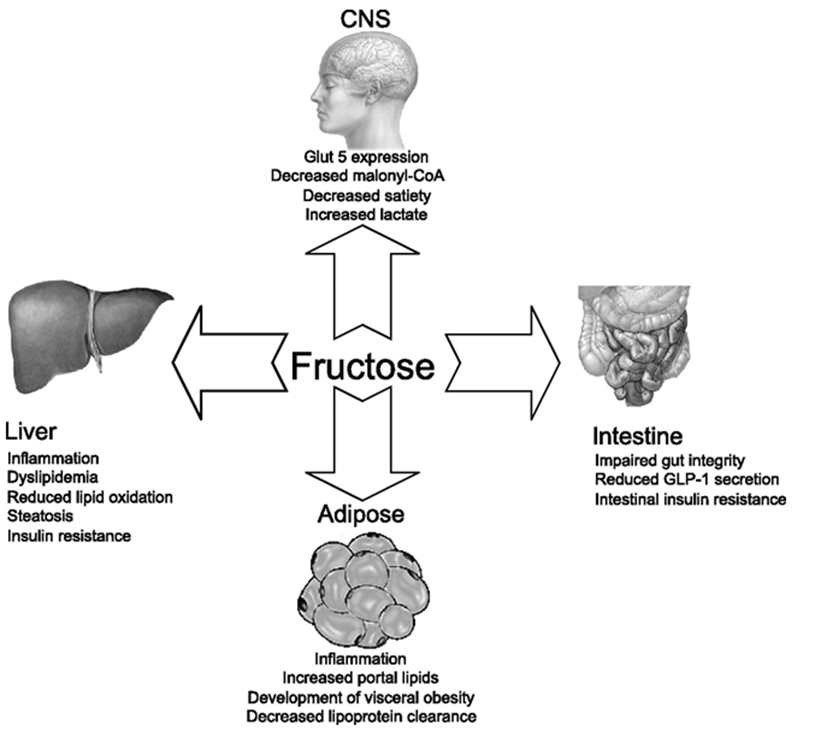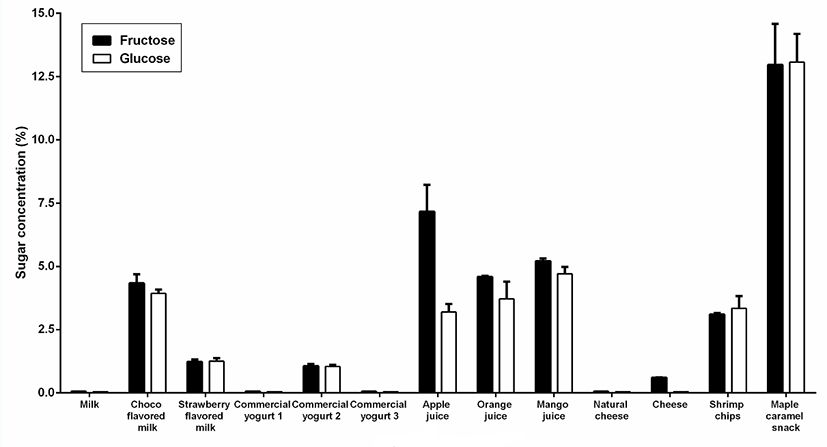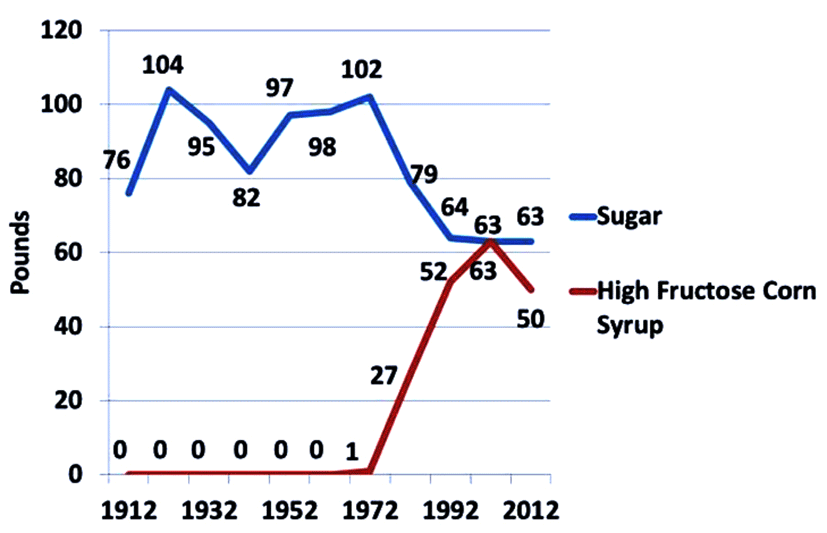Introduction
Until the 1970s, cane sugar had been people’s most delightful sweetener of choice (Goran et al., 2013). However, when the much less expensive corn-derived sweeteners like maltodextrin and high-fructose corn syrup (HFCS) were developed, HFCS intake has increased rapidly (Forshee et al., 2007). According to the Corn Refiners Association, HFCS is “either 42 percent or 55 percent fructose” combined with the remaining percentage of glucose, although HFCS with higher fructose content could be produced (Hanover and White, 1993; White, 2008). In general, regular table sugar (sucrose) is 50% fructose and 50% glucose, but HFCS could contain up to 80% (or 42~55%) fructose and 20% (or 45~58%) glucose, almost twice the fructose of common table sugar (Babacanoglu et al., 2013).
In USA, the consumption of total fructose increased by nearly 30% between 1970 and 2000, largely due to the increased use of HFCS (Bray et al., 2004). Also many people are being poisoned by a common additive present in a wide array of processed foods like breakfast cereals, breads, cakes, cookies, soft drinks, salad dressings, and so on (Ventra et al., 2010). This additive increases the risk of atherosclerosis, diabetes, fatty liver disease, hypertension, obesity, etc., and this toxic additive is HFCS (Parrish, 2010; Latulippe and Skoog, 2011) (Fig. 1).

Furthermore, in recent years, the metabolism due to excessive intake of fructose is the major concern (Akar et al., 2012). The alarming rise in diseases has been mirrored by an equally dramatic increase in fructose consumption, particularly in the form of the corn-derived sweetener, HFCS (Iida et al., 2013) .
Hence, the objective of this study was to conduct to analyze the contents of fructose and glucose on various popular sweetened beverages based on milk using HPLC method.
Material and Methods
Thirteen samples of various popular sweetened beverages based on milk were purchased in Seoul, South Korea from August 2016 to January 2017 (Table 1). All of the samples was domestically produced in South Korea. Samples were purchased and shipped to the laboratory. For sample analysis, sample preparations were conducted following Zeppa et al. (2001) with some modifications.
Reference standards of glucose, galactose, fructose, lactose (purity ≥ 99.0%) were purchased from Sigma–Aldrich (St. Louis, MO, USA). Deionized water was purified by a Milli-Q system (Milipore Corp., Bedford, MA, USA) and1N sulfuric acid was from Fischer Scientific (Piscataway, NJ, USA) and diluted with deionized water for use. All solvents were HPLC-grade and were used without further purification. A set of standard solutions and quality control (QC) solutions for varous sugars were prepared by successive dilution of the stock solutions (1 mg/mL for each standard samples) with purified deionized water. All solutions were stored at −80℃ until used in analyses.
Sample analysis was performed using Agilent 1260 HPLC ChemStationTM (Agilent,Palo Alto, USA) equipped with UV Detector and RI detector (Table 2). The separation of each sample was performed on a Hi-Plex Ca column (6.5 mm×300 mm) using an automatic injector (G1367E, 1260 Hip-ALS, Agilent Technologies 1290 Infinity) and Guard Column (4.6 mm ID × 12.5 mm, Agilent, USA). Mobile phase was deionized H2O at a flow rate of 0.6 mL min−1. The column and auto-sampler tray were maintained at 80℃ and 4℃, respectively. The analytical run time was 30 min.
For assessing the reliability of this study, all data obtained this study were statistically analyzed and also were recalculated total sugar content in grams per 100 mL by summing the fructose, glucose, and sucrose results using the coefficient of variation for the standard solutions. The concentration of lactose, glucose and galactose were computed for Least-Squares means using SPSS GLM procedures, and mean concentrations were tested for significance (p<0.05) using Duncans multiple range test. The experiment was duplicated.
Results and Discussion
As shown in Table 1, the total monosaccharide (fructose+ glucose) content of various popular sweetened beverages based on milk ranged from 0.60 g/100 mL (cheese) to 26.03 g/100 mL (maple caramel snack), but only milk showed 0 g/100 mL. Choco flavored milk and strawberry flavored milk showed 8.26 g/100 mL and 2.46 g/100 mL, respectively. Three different commercial yogurts contained from 0.51 g/100 mL, 0.86 g/100 mL, 2.34 g/100 mL, respectively. In Juice, the content of Orange was 8.30 g/100 mL, Mango was 9.91 g/100 mL, and Apple was 10.35 g/100 mL. Shrimp chips showed 6.44 g/100 mL. but there was no difference between Natural cheese (0.08 g/100 mL) and Cheese (0.60 g/100 mL). According to previous research, Ventra et al.(2011) reported that the total sugar content of the beverages ranged from 5.5 g/100 mL to 12.7 g/100 mL. The results of this study showed that the content of sugar of various popular sweetened beverages based on milk varied differently depending on the food categories but showed the similar pattern (Table 1).
As shown in Fig. 2, the fructose-to-glucose ratio of various popular sweetened beverages based on milk showed from ND (Not detected) to 2.24. But the content of glucose contained higher than that of fructose in only 3 samples- Strawberry flavored milk, Shrimp chips, and Maple caramel snack (Table 1).

To compare with previous study, the fructose-to-glucose ratio of Coca-Cola varied from 58:42 to 65:35 for the three sample of USA, but that of Mexican Coca-Cola sample showed 52:48. Also, the fructose-to-glucose ratio of the three samples of Sprite ranged from 59:41 to 64:36 and the three samples of Pepsi ranged from 58:42 to 65:35 (Ventra et al., 2011).
The results of this study showed that various popular sweetened beverages based on milk contained higher fructose than glucose and showed the similar pattern (Fig. 2 and Table 1).
In general, sucrose (table sugar) as disaccharide was composed of fructose and glucose. Despite its very similar chemical structure, fructose and glucose were absorbed and metabolized by completely different pathways. In contrast to glucose, fructose was absorbed through the GLUT-5 receptor in the gut and was metabolized mostly in the liver by a pathway which was not dependent on insulin (Douard and Ferraris, 2008; Gaby, 2005). Hence, fructose consumption did not stimulate insulin secretion or leptin production by adipose tissue and could contribute directly to weight gain (Teff et al., 2009; Stanhope and Havel, 2008). Furthermore, excess consumption of fructose was related to the specific accumulation of visceral fat and associated metabolic risk factors as insulin resistance than excess consumption of glucose (Stanhope et al., 2009).
Furthermore, the yearly consumption of HFCS increased by over 1,000%, greatly exceeding the change in consumption of any other food or food group between 1970 and 1990 (Fig. 3). Hence, HFCS is now the main caloric sweetener added to soft drinks in the world, and comprises more than 40% of caloric sweeteners added to foods and beverages. table-wra

Using HPLC analysis, this study showed similar significant findings (Ventura et al., 2011). At first, the total carbohydrate content of various popular sweetened beverages based on milk varies from the food label provided by the food company. At second, the fructose-to-glucose ratio in various popular sweetened beverages based on milk showed difference according to food categories. At last, the type of sugar detected by the HPLC analysis was not always consistent with the type of sugar (lactose, fructose, glucose, galactose) listed on the food label.
Until now, HFCS grimly and quietly entered the food supply decades ago (Kimber and Stanhope, 2016). Recently, HFCS is omnipresent in a wide variety of foods. HFCS has been related to an increased risk of a broad range of metabolic diseases and conditions (Rippe and Angelopoulos, 2016). Namely, excessive intake of dietary fructose from sources such as HFCS could contribute to myriad adverse health effects ranging from metabolic syndrome to kidney stones to the complications of diabetes (Yu et al., 2013). Therefore, the best way to reduce the intake of HFCS is to read the food label of food products before purchasing them, and also avoiding foods which contain HFCS and another added sugars such as sucrose (Campos and Tappy, 2016). Therefore, the results of this study could show the basic important information to estimating fructose consumption and also the relationship between fructose consumption and metabolic health. Then, the further studies are needed to assess current outcome.






